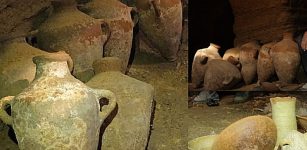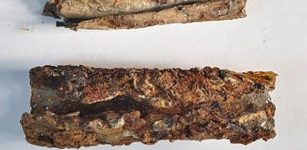Mythical Temple Of Wingded Warrior God Haldi In The ‘City Of The Raven’
Ellen Lloyd - AncientPages.com - Scientists have been searching for an ancient temple dedicated to a winged warrior god Haldi for centuries.
Was the temple just an ancient myth or did it exist in reality?
Now, a dedicated local archaeologist thinks he has finally located this remarkable mythical temple in the "City of the Raven" where it resided. The problem is the ancient ruins are in the middle of a war zone and this piece of ancient history could be destroyed at any time. More than 2,500 years ago, the temple was the shining glory of the ancient capital city of Musarir, also known as Ardini, in modern-day Iraqi Kurdistan.

Haldi (Khaldi) was one of the three chief deities of Ararat (Urartu). Of all the gods of the Ararat pantheon, the most inscriptions are dedicated to him. (Image credit: Erebuni Fortress Museum: Yerevan, Armenia)
It is widely believed that the temple was built in the late ninth century BC to honor the god Haldi, a winged warrior standing on a lion, and the goddess Bagbartu in the Iron Age kingdom of Urartu, which considered Haldi its national deity.
In ancient times, Musarir was referred to as the "City of the Raven". This is interpreted by scholars in various ways.
Some think that the raven could be related to Haldi because Mithra was another face of Haldi in the Roman period, and the raven was one of the symbols of Mithra.
There are supposed to be underground temples of Mithra in the Bradost caves. Other archaeologists have proposed City of the Raven got its name because the houses of the city were built on a rocky mountain slope, nesting there like ravens.
The capital city had long been written about, first by an Assyrian king who said it was "the holy city founded in bedrock," then by a later king who referred to the city's ruler as a "mountain dweller," and its own seal called it "the city of the raven."
Marf Zamua, who teaches at Salahaddin University in Erbil, the capital of Iraqi Kurdistan, and is working on his PhD in Assyriology in the Netherlands, began collecting these recently exposed pieces. The 17 column fragments he has found so far have led him to believe he's discovered the long-lost temple of the winged warrior god Haldi. Along with these major finds are a collection of relics, seven stone statues, pottery, and a bronze depiction of a wild goat found in the area.
Zamua went from village to village looking for what had been uncovered. "Most of the objects [were] re-used for their daily life, such as using column bases as stairs and seats and statues as column stones in their houses," he said.

The private houses of the city have been called by some scholars as a fortress on a mountain or temple storage on four levels, or as “a four-storied building”.
He also made a connection between architectural similarities between the modern village and the ancient city-idiosyncrasies in building styles that are uncommon elsewhere in the region, like the lack of outer compound walls and stacked houses.
According to Paul Zimansky, Professor of archaeology and ancient history at Stony Brook University, the general area has been thought to contain the mythic temple for many years. Although he is not yet fully convinced the temple's discovery, he says the bases found "may well belong to some sort of public building of the appropriate time." He calls Marf Zamua's discoveries "a major contribution to the archaeology of this valley."
"I hope he can continue his work in spite of all the political turmoil," Zimansky says. "The remoteness of the area has been both its curse and its blessing throughout history."
The ancient temple is in the middle of a war zone and uncovering ancient treasures in Iraq has posed a huge challenge for excavators.
In the same way, as Sargon II plundered Urartu to fund his war chest, antiquities across Syria and Iraq have been bombed flat and looted by rebels and government forces alike. In Iraq, invading militants of the Islamic State of Iraq and al-Sham have torn through Mosul's museum and are destroying ancient treasures at an alarming rate.
Marf Zamua denounces the pillaging but says the rebels have been targeting Islamic architecture and relics more than pre-Islamic sites. Luckily, the Kurdish army has been successfully protecting the border since the surge, and Marf Zamua says he's unconcerned about the interference with his work-he and the local antiquities department are moving ahead with plans to launch fuller excavations into locations where the objects were found
There is no telling whether the remnants of a mythic temple built to honor a winged man on a lion's back will survive its resurrection.
"They destroy anything they do not like," Marf Zamua says of the modern-day invaders.
Written by - Ellen Lloyd – AncientPages.com
Copyright © AncientPages.com All rights reserved. This material may not be published, broadcast, rewritten or redistributed in whole or part without the express written permission of AncientPages.com
More From Ancient Pages
-
 1,000-Year-Old Multi-Shaped, Double-Sided Mold For Jewelry Found In Swiss City Of Chur
Artifacts | Jul 26, 2020
1,000-Year-Old Multi-Shaped, Double-Sided Mold For Jewelry Found In Swiss City Of Chur
Artifacts | Jul 26, 2020 -
 Preserve Elfdalian: Sweden’s Secret Forest Language From The Viking Era
Civilizations | May 21, 2015
Preserve Elfdalian: Sweden’s Secret Forest Language From The Viking Era
Civilizations | May 21, 2015 -
 Treasure Of 1,753 Roman Silver Coins Accidentally Discovered In Poland
Archaeology | Apr 1, 2020
Treasure Of 1,753 Roman Silver Coins Accidentally Discovered In Poland
Archaeology | Apr 1, 2020 -
 Missing ‘Delmenhorst’: 17th Century Danish Warship From ‘Battle Of Fehmarn’ Found
Archaeology | Sep 22, 2020
Missing ‘Delmenhorst’: 17th Century Danish Warship From ‘Battle Of Fehmarn’ Found
Archaeology | Sep 22, 2020 -
 Roman-Era Residence Unearthed In Ancient Capital Of Memphis, Egypt
Archaeology | Sep 27, 2018
Roman-Era Residence Unearthed In Ancient Capital Of Memphis, Egypt
Archaeology | Sep 27, 2018 -
 Lost Q Source Remains An Unsolved Biblical Mystery
Biblical Mysteries | May 7, 2017
Lost Q Source Remains An Unsolved Biblical Mystery
Biblical Mysteries | May 7, 2017 -
 Could Doggerland Be Europe’s True ‘North Atlantis’ Of Stone Age?
Featured Stories | Nov 19, 2018
Could Doggerland Be Europe’s True ‘North Atlantis’ Of Stone Age?
Featured Stories | Nov 19, 2018 -
 Man-Made Square Burial Cave Dated To Rameses II-Era Accidentally Found In Israel
Archaeology | Sep 19, 2022
Man-Made Square Burial Cave Dated To Rameses II-Era Accidentally Found In Israel
Archaeology | Sep 19, 2022 -
 What Did Ancient Mesoamerican Civilizations Know About Unusual Powers Of The Mind?
Ancient Mysteries | Feb 13, 2020
What Did Ancient Mesoamerican Civilizations Know About Unusual Powers Of The Mind?
Ancient Mysteries | Feb 13, 2020 -
 1,000 Bog Bodies From Across Scandinavia Reveal More Ancient Secrets – Here’s What Scientists Found
Archaeology | Mar 20, 2023
1,000 Bog Bodies From Across Scandinavia Reveal More Ancient Secrets – Here’s What Scientists Found
Archaeology | Mar 20, 2023 -
 On This Day In History: Mary Queen Of Scots Born – On December 8, 1542
News | Dec 8, 2016
On This Day In History: Mary Queen Of Scots Born – On December 8, 1542
News | Dec 8, 2016 -
 Roman Forum (‘Forum Romanum’) – The Heart Of Ancient Rome
Featured Stories | Aug 5, 2019
Roman Forum (‘Forum Romanum’) – The Heart Of Ancient Rome
Featured Stories | Aug 5, 2019 -
 Unique Bones Decorated With Black Markings Discovered In 4,500-Year-Old Tomb In Ukraine
Archaeology | Jul 30, 2018
Unique Bones Decorated With Black Markings Discovered In 4,500-Year-Old Tomb In Ukraine
Archaeology | Jul 30, 2018 -
 Has The Mystery Of The Secret Sarcophagus Found At Notre-Dame Cathedral Been Solved?
Archaeology | Sep 25, 2024
Has The Mystery Of The Secret Sarcophagus Found At Notre-Dame Cathedral Been Solved?
Archaeology | Sep 25, 2024 -
 On This Day In History: Treaty Of Worms Signed Between Great Britain, Austria And The Kingdom Of Sardinia – On Sep 13, 1743
News | Sep 13, 2016
On This Day In History: Treaty Of Worms Signed Between Great Britain, Austria And The Kingdom Of Sardinia – On Sep 13, 1743
News | Sep 13, 2016 -
 Stone Box With Ancient Shell Llama Offering Found In Lake Titicaca
Archaeology | Aug 4, 2020
Stone Box With Ancient Shell Llama Offering Found In Lake Titicaca
Archaeology | Aug 4, 2020 -
 Extraordinarily Well-Preserved 3,000-Year-Old Octagonal Sword Unearthed In Germany
Archaeology | Jun 15, 2023
Extraordinarily Well-Preserved 3,000-Year-Old Octagonal Sword Unearthed In Germany
Archaeology | Jun 15, 2023 -
 1,400-Year-Old Iron Hammer And Nails Among Findings At Sanhedrin, Western Galilee’s Usha
Archaeology | Nov 6, 2019
1,400-Year-Old Iron Hammer And Nails Among Findings At Sanhedrin, Western Galilee’s Usha
Archaeology | Nov 6, 2019 -
 London Is Twice As Old As Previously Thought – New Discovery Reveals
Archaeology | Apr 9, 2020
London Is Twice As Old As Previously Thought – New Discovery Reveals
Archaeology | Apr 9, 2020 -
 CT Scanning And 3D-Modelling Used To ‘Unfold’ Ancient Silver Plate Found In Jerash
Archaeology | Dec 26, 2015
CT Scanning And 3D-Modelling Used To ‘Unfold’ Ancient Silver Plate Found In Jerash
Archaeology | Dec 26, 2015




